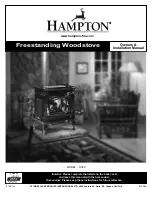
05.3 STOVE EFFICIENCY
Paradoxically, highly efficient stoves may pose difficulties for fume extraction.
In order for a flue pipe to work properly its internal temperature must increase as a consequence of the fumes
generated during combustion.
Now, the efficiency of a stove is determined by its capacity to transfer most of the head produced into the area
to be heated: the consequence of this is the greater the efficiency of the stove, the cooler the combustion
smoke residues are and as a result the lesser the draught.
A traditional chimney flue, with a rough design and insulation, is more efficient if used with a traditional open
fireplace or a poor-quality stove where most of the heat is lost with the fumes.
Therefore, purchasing a quality stove often entails modifying the existing chimney flue to obtain a better
insulation, even when it already works properly with old appliances.
Poor draught results in the stove not operating when hot or in smoke spillage.
•
Connecting the stove pipe to an existing chimney flue that has already been used with an old appliance is
a common mistake. In this way two solid-fuel appliances share the same chimney flue, which is wrong and
dangerous.
•
If the two appliances are used simultaneously, the fume load might exceed the existing chimney flue
capacity resulting in downdraught. If only one appliance is used, the fume heat will facilitate draught but
the cold air coming from the other appliance not in use will cool down exhaust fume temperature again blocking the draught.
•
Besides the problems described so far, if the two appliances are placed on different levels the communicating vessel principle might be interfered with, causing
combustion fumes to be drawn in an irregular and unforeseeable way. Installation warnings
05.4 STOVE SPECIFICATIONS FOR FLUE PIPE SIZING
COSTANZA
Chimney flue draught
12 Pa
Fume temperature
168 °C
Maximum flue gas flow rate
7.7 g/s
IMPORTANT: THE LENGTH OF THE FUME DUCT PIPE MUST HAVE A DIAMETER EQUAL TO OR GREATER THAN THAT SPECIFIED FOR EACH
APPLIANCE. EVERY 90° ELBOW OR (T) COUPLING IS THE EQUIVALENT OF 1 METER OF PIPE.
IN ORDER TO GUARANTEE CORRECT EFFICIENCY OF THE STOVE, ENSURE THE FOLLOWING TYPES OF INSTALLATION BEFORE CONNECTION TO
THE FLUE PIPE:
INSTALL THE PRODUCT WITH AT LEAST ONE (T) AND 1 METERS OF PIPE CERTIFIED ACCORDING TO EN 1856-2
06. INSTALLATION WARNINGS
By using coaxial tubes, the air will be pre-warmed contributing to improved combustion and
lower emissions into the atmosphere.
Before installing, the following indications must be met:
Select the position where the stove is to be installed and:
•
Arrange the connection to the flue pipe for fume extraction.
•
Arrange the external air intake (combustion air).
•
Arrange the connection to the earthed mains.
•
The electrical system of the room where the stove is to be installed must be earthed,
otherwise the control board may not work properly.
•
Place the stove on the floor in a convenient position for the connection to the flue pipe and
close to the combustion air intake.
•
The appliance must be installed on a floor with an adequate loading-bearing capacity.
•
Should the existing floor not comply with the requirement above, proper measurements
must be taken (for instance, the installation of a load distribution plate).
•
All the structures which could catch fire if exposed to excessive heat must be protected. Floors made from wood or inflammable materials must be protected
using non-combustible materials (e.g. 4mm-thick sheet metal or ceramic glass).
•
The appliance installation must ensure easy access for cleaning the stove, exhaust pipes and flue pipe.
•
This appliance is not suitable to be installed on a shared flue pipe.
•
During normal operation, the stove draws air from the room where it is installed. Therefore, an external air intake must be positioned at the same height of the
pipe located on the stove back. Exhaust fume pipes must be suitable for pellet stoves and must therefore be made from coated steel or stainless steel, with a
diameter of 8cm and fitted with adequate gaskets.
•
The "air combustion" socket must reach an external wall or a wall of an adjacent room with external ventilation, as long it is not a bedroom or bathroom, nor
at risk of fire such as garages, storage rooms, combustibles stores, etc. These air vents must be made in such a way that they cannot be blocked either
internally or externally and should be protected by a grille, metal net or other suitable protection without reducing the minimum dimensions.
8











































